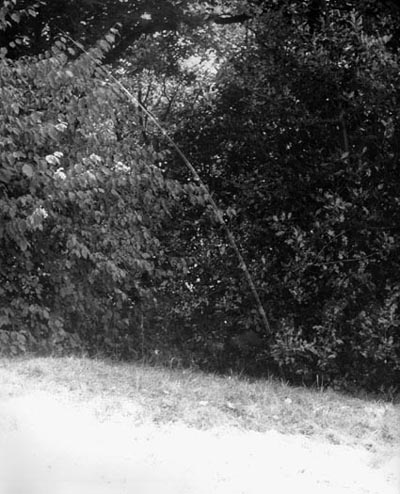 Jochen Lempert Evidence as to man's place in nature Click for English text Die Galerie Reinhard Hauff freut sich, ihre zweite Ausstellung mit dem in Hamburg lebenden Künstler Jochen Lempert (*1958) eröffnen zu können. Jochen Lempert, der in diesem Jahr den renommierten Edwin-Scharff-Preis der Stadt Hamburg verliehen bekommen hat, reflektiert in seinen Arbeiten das Verhältnis von Mensch und Tier, von Naturwissenschaft und Kunst. Zwischen wissenschaftlicher Systematik und freier Assoziation lenkt er in seinen oft humorvollen Schwarz-Weiss-Fotografien den Blick auf die Allgegenwart unserer anthropomorphen Projektionen auf das Tier, auf subtile Überschneidungen und Analogien zwischen dem menschlichen und tierischen Bereich. Wenn das fotografische Abbild der Blätter einer Strassenlinde so vergrössert wird, dass die Körnung des Papiers genau der Grösse einer Blattlaus entspricht, die - obwohl auf dem Blatt vorhanden, so doch auf der Fotografie unsichtbar - der eigentliche Grund für die Entstehung der Aufnahme war, oder wenn in der Dunkelkammer das Leuchten der auch als "Meeresfunken" bekannten Alge Noctiluca seine Spuren auf dem Papier in Form eines Fotogramms hinterlässt, dann entstehen genau die Zweideutigkeiten zwischen Naturphänomen und fotografischem Abbild, die den auch als Biologen ausgebildeten Künstler interessieren. Bei seinen Streifzügen durch die den Menschen umgebende Tierwelt beschäftig er sich mit so alltäglichen Erscheinungen wie dem Vogelzug der Gänse, dem Nestbau der Elstern, dem Markierverhalten von Hunden oder mit Spinnenweben im Wind. Die mit der Kamera eingefangenen Ergebnisse seiner Feldforschungen präsentiert Lempert in seinen Ausstellungen stets so, dass die Ambivalenz von technischem Apparat und beobachteter Natur eine Vielzahl möglicher Bezüge zwischen natürlichem Lebenraum und künstlicher Umwelt sichtbar macht. Natur- und Kunstformen verschwimmen, häufig bleibt unklar, ob der vermeintliche Gegenstand auf dem Bild real oder nur ein Kratzer auf dem Negativ ist. Der Titel der Ausstellung "Evidence as to man's place in nature" zitiert ein Buch des britischen Naturforschers und Biologen Thomas Henry Huxley (1825-1895), in dem - inspiriert von Darwins Evolutionstheorie - erstmals die Abstammung des Menschen von den Menschenaffen bewiesen wird. Übertragen auf ein Medium, das heute längst seine Beweiskraft eingebüsst hat, erscheint Jochen Lemperts konsequentes Festhalten an der analogen Fotografie wie ein anachronistischer, poetischer Reflex. Die in seinem enzyklopädisch angelegten Werk immer wieder implizit gestellte Frage, wie wir unsere natürliche Umwelt wahrnehmen, lässt dabei letztlich offen, was überhaupt mit Hilfe der Fotografie als traditionelles Erkenntnismedium der Wissenschaft abbildbar ist. Ausstellungsdauer 16.6. - 29.7.2006 Öffnungszeiten Di-Fr 14 - 19 Uhr, Sa 11 - 15 Uhr, sowie nach Vereinbarung Galerie Reinhard Hauff Paulinenstrasse 47 D-70178 Stuttgart Telefon +49 711 609 770 Fax +49 711 620 26 67 Email galerie@reinhardhauff.de www.reinhardhauff.de Jochen Lempert Evidence as to man's place in nature Galerie Reinhard Hauff is pleased to announce the opening of its first solo show with the Hamburg artist Jochen Lempert (*1958). Lempert, who this month receives the prestigious Edwin-Scharff-Prize from the City of Hamburg, has a degree in biology. His black and white photographs observe the relationship between Man and Animal, and that of the Natural Sciences and Art. Combining the systematic approaches and methods of scientific research on the one hand, with free association and artistic license on the other, his photographs present subtle, frequently humourous analogies and juxtapositions of Man and Animal, and guide the viewer towards the discovery of some of those many things in the world that surrounds us, which do not immediately meet the eye. Lempert photographs an aphid sitting on the leaf of a lime tree in the street, but enlarges the image so much that the aphid itself becomes precisely the size of a grain in the structure of the photographic paper, and thereby no longer visible in the print. When working in his darkroom, he fixes traces of the glow of the "Alge Noctiluca" - also known as Ocean Sparks - on the paper as a photogramme. In such situations, an ambiguitiy between natural phenomena and photographic image comes about, and this is what the educated biologist is interested in. On expeditions through the animal world surrounding Man, the artist looks for seemingly unspectacular occurences such as a train of wild geese, Magpies building nests, dogs marking their territory - or spiderwebs in the wind. The results of these fieldtrips - as caught on camera - are presented in Lempert's exhibitions, so that the ambivalence between technical equiment and nature observed make endless possible relationships between natural habitat and artificial environment obvious. Nature and artificial forms blend into each other to the extent that it is often unclear whether it is an actual object which appears on a photo, or just a scratch in the negative. The titel of the exhibition "Evidence as to Man's Place in Nature" is taken from a book by the British natural scientist and biologist Thomas Henry Huxley (1825-1895), in which - inspired by Darwin's Theory of Evolution - Man's origin from apes is proven for the first time. In an age where photography has lost its credibility as bearer of evidential values, Lempert's consistent adherence to analogous photography seems like an anachronistic, poetic reflex. The questions which are implicitly and repeatedly asked in Lempert's encyclopedic work, namely how we perceive our natural environment - leave open if, when and what photography can indeed reproduce and/or transmit in an open environment of scientific (observation) research and artistic perception. Exhibition 16 June - 29 July 2006 Gallery hours Tues-Fri 2 - 7 pm, Sat 11 am - 3 pm and by appointment |